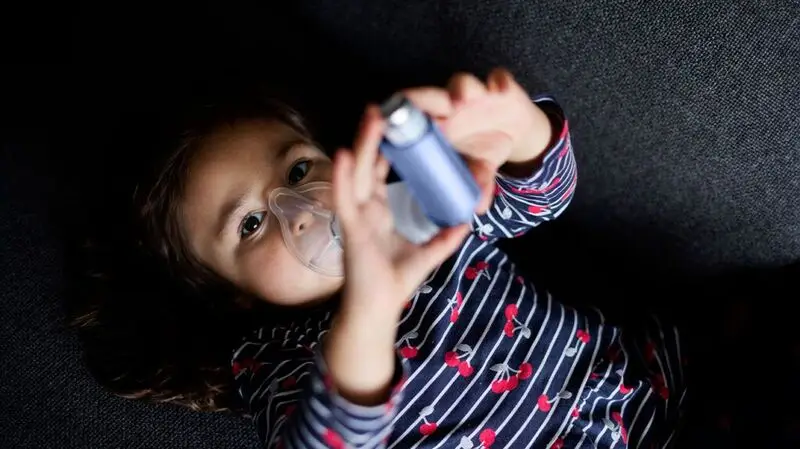
- Asthma is common in young children.
- Diagnosing asthma exacerbations in those under 5 years is challenging.
- A recent study looked at an artificial intelligence designed stethoscope that combines auditory data with physical measurements.
- The researchers concluded that the new tool successfully detects exacerbations in children under 5.
In the United States, around 1 in 12 people have asthma — that’s around 27 million people.
Of these, about 4.5 million are under 18, making asthma the most common chronic disease in children.
Although asthma is
Reducing these risks relies on predicting exacerbations or catching them early. This makes accurate and careful monitoring vital.
However, this can be challenging in younger children, although a new stethoscope that utilizes artificial intelligence may make this task easier.
Adults and children older than 5 can use pulmonary function tests, which measure peak expiratory flow rate. For young children, however, these tests are often little help.
Medical News Today spoke with Dr. Alan Kaplan, the chair of the Family Physician Airways Group of Canada about the issue.
“Children are tougher to assess as they have more trouble describing their symptoms and often just accept them,” he said.
For example, one
With these measures largely ineffective for children under 5, doctors rely on listening to features of the child’s breathing, such as wheezing and rhonchi — low-pitched gurgles produced when breathing out.
Doctors generally assess these so-called auscultatory phenomena in face-to-face appointments. This makes them less useful for catching exacerbations early and identifying the triggers. Additionally, monitoring sounds is largely subjective.
Could a solution based on artificial intelligence be the answer?
A recent study, which appeared in the journal Annals of Family Medicine, investigated a home stethoscope aided by artificial intelligence (AI) called StethoMe.
It should be noted that 6 of the 13 study authors are either employees or shareholders or both in the company that produces StethoMe.
StethoMe detects ongoing sounds, such as wheezing and rhonchi, but it also detects intermittent sounds such as crackles.
It combines this auditory data with physical measurements, including heart rate, respiratory rate, and inspiration-to-expiration duration ratio.
The researchers wanted to identify which of these parameters are most useful for detecting exacerbations. They also wanted to gauge whether this home-based testing was useful for children too young to use standard tests.
The researchers recruited 90 children and 59 adults with asthma and followed them for 6 months.
Participants, or parents of participants, used three tests throughout the study:
- AI-aided stethoscope
- peripheral capillary oxygen saturation (SpO2) meter
- peak expiratory flow meter
They also completed health surveys throughout, including information on subjective breathing quality. All data was collected in a smartphone app.
Participants or parents carried out these tests once each day for the first 14 days, then at least once each week for the remainder of the study. This yielded 6,442 complete examinations.
Doctors evaluated each examination for the presence of exacerbations. For each parameter, the scientists trained a machine-learning model to investigate which was most useful for spotting exacerbations.
The authors wrote that, in young children, “subjective information noted by parents was not sufficient to confirm or exclude the appearance of an exacerbation.”
They concluded that this observation demonstrates that untrained people cannot use subjective measures to accurately predict or confirm asthma exacerbations.
The researchers also reported that individually, peak expiratory flow, SpO2, heart rate, respiratory rate, and inspiration-to-expiration duration ratio are “relatively weak indicators” of exacerbation.
Of all single measures, continuous auscultatory sounds were the most effective.
When using multiple measures, combining the AI-aided stethoscope with survey information, peak expiratory flow and SpO2 provided the best chance at identifying exacerbation in all age groups.
Also, in children, data from the AI-aided stethoscope performed just as well as combining all parameters.
“[U]sing AI-aided stethoscopes facilitates the detection of exacerbations with high effectiveness even in children younger than 5 years of age,” the study authors wrote.
When the researchers looked at the data from adults, they found that participants’ reports of asthma symptoms were the most effective way to diagnose exacerbations.
Together, the authors concluded that adults can gauge their symptoms well, whereas the parents of children with asthma find it more challenging to describe their child’s symptoms.
Medical News Today also spoke with Dr. Rachel Foong, a senior research fellow in the Children’s Lung Health Team at Telethon Kids.
While Foong was not surprised that “auscultatory sound measured via stethoscope are more useful in children, and that symptoms and breathing parameters are the main associating factor in adults,” she thought the study was a “clever idea.”
Foong, who was not involved in the study, also said that she “would be interested to know if there were any abnormalities that could be identified prior to the exacerbation occurring, and how early these could be detected.”
The authors said they hope that this tool will help clinicians and parents more accurately monitor childhood asthma. With increased interest in
“AI-aided stethoscopes are a particularly useful tool that can be applied to optimize and improve patient-doctor collaboration using telemedicine solutions.”
While Kaplan believes the premise of this study is interesting, he adds a note of caution: “This technology cannot be trusted by itself, as some asthmatics get breathless, with worsening obstruction and do not wheeze.”
“With the shortage of physicians worldwide,” he continued, “this tool might be useful, but I am certain that cost will be a huge barrier. The other barrier will be working out a process for dealing with a positive ‘screen.’”
Foong agrees with the concerns regarding accessibility.
“I think the overall usefulness of this technology would also depend on the accessibility and affordability of these devices for use in families experiencing asthma,” she explained.
“Studies have shown that asthma disproportionately affects minority and low-income children and unless development of these technology consider the needs of the users they may only be useful to those that have access,” she added.
Overall, though, Foong said she is excited about the prospect of using artificial intelligence.
“Research using AI is… uncovering novel findings to help understand the disease further,” she said. “My view is that using AI for asthma predictive models to determine who would develop asthma or have severe symptoms that would benefit from certain therapies is the most promising.”





